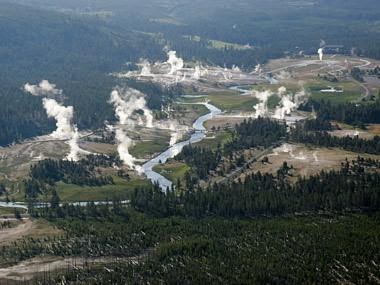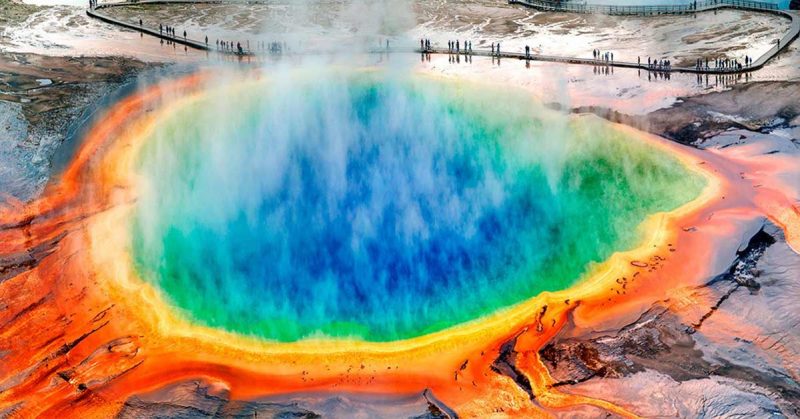With about 700 to 3,000 earthquakes recorded within its environs every year, Yellowstone is regarded as one of the most earthquake-prone places in the United States.
On Friday, May 29, the United States Geological Survey recorded not less than 11 earthquakes within West Yellowstone, an area largely situated in the state of Montana. [1] Excluded from the earthquake count were dozens of other smaller tremors that rocked the region following the park’s reopening on Monday, May 18. At about 11:39 am that Friday, the largest earthquake struck at a magnitude of 3.1. In the past month, West Yellowstone has been hit by a total of 34 earthquakes.

According to the park’s officials, these earthquakes are usually below a magnitude of 2, averaging at about 1.5 and so no one would exactly feel the tremors. [2] However, in several areas surrounding the park, the USGS recorded a total of 70 small earthquakes occurring in a swarm over 24 hours. Tremors were detected at a distance 15 miles outside the park at depths between 1.4 and 6 miles below the earth’s surface.
Park officials say there is nothing for the public to worry about since the so-called earthquake swarms are not unusual and account for over 50% of all tremors detected in the area. They also report that these minor quakes are caused by volcanic fluids flowing into shallow rock fractures.
Fears over supervolcanic eruptions
The recent swarms of earthquakes have renewed concerns in the area about supervolcanic eruptions, although the statistics are highly unlikely. The USGS reports that the odds of a supervolcano going off in Yellowstone is about 1 in 730,000. [3] This is an extremely long shot, so there’s no need for panic as the area continues to reopen to visitors this June.
The Yellowstone Park is home to the Yellowstone Caldera, one of the only two supervolcanoes in the United States. Located in the northwest of Wyoming, along with most of the park, the Caldera measures about 34 by 45 miles (55 by 72 km). Historically, three eruptions of the supervolcano have occurred in the past, the last of which created the Yellowstone Caldera some 630,000 years ago. No eruptions have been recorded in recent times. A caldera is simply a geographic depression formed when volcanos empty chambers of magma and the surrounding land caves into the emptied hole.
According to the National Park Service: “Yellowstone is one of the most seismically active areas in the United States…. Approximately 700 to 3,000 earthquakes occur each year in the Yellowstone area; most are not felt. They result from the extensive network of faults associated with the volcano and surrounding tectonic features.” [4]
As the park continues to dole out its reopening polices…
On March 24, 2020, based on recommendations from national and local health authorities, the Yellowstone National park was indefinitely closed due to the COVID-19 pandemic. As America’s oldest national park and also the world’s first, the park attracts millions of tourists every year and generates hundreds of millions in revenue to its host states and surrounding communities. [5] While 96% of the park is located in the state of Wyoming, it has multiple entrances across Montana and Idaho which are all being regulated as tourist activities resume.
The park was reopened for the first time in two months on Monday, May 18, and as expected, it was flooded by thousands of visitors from all over the states in a few hours.
Although there are no imminent supervolcano threats to tourists, the real dangers may lie in larger earthquakes beyond two and three magnitudes and hydrothermal blasts. However, the USGS is constantly monitoring seismic activity and would hopefully detect any real threats before they occur.
While Yellowstone is a relatively safe tourist location, people often get hurt in more mundane ways than they would normally imagine. [6] Getting mauled by wildlife seems like the most imaginable scenario, but car accidents caused by distracted drivers and falls into the Grand Canyon are quite common. Some people have unknowingly taken fatal dives into water boiling beyond 200 degrees. Others have been severely scalded by fumes from hydrothermal vents, and under sadly unforeseen circumstances, a guy lost his life after he got hit by a falling tree. [7]
Yellowstone is the place to connect with nature and feel the wildest kind of free, but you’ve also got to keep your eyes open and be extremely careful.
References
- ” Nearly a dozen earthquakes shake near Yellowstone National Park in 24 hours.” KUTV. McKenzie Stauffer. Retrieved June 17, 2020.
- “Yellowstone national park hit with multiple earthquakes in 24 hours.” Independent. Gino Spocchia. Retrieved June 17, 2020.
- “Questions About Supervolcanoes.” USGS. Retrieved June 17, 2020.
- “Earthquakes.” NPS. Retrieved June 17, 2020.
- “Tourism to Yellowstone creates $629.6 million in economic benefits.” NPS. Morgan Warthin. Retrieved June 17, 2020.
- “How do people get hurt at Yellowstone? It’s not what you think.” Trib. Lillian Schrock. Retrieved June 17, 2020.
- “Yellowstone visitor dies after being struck by tree.” Trib. Lillian Schrock. Retrieved June 17, 2020.
- “Yellowstone Caldera.” Britannica. Kenneth Pletcher. Retrieved June 17, 2020.

